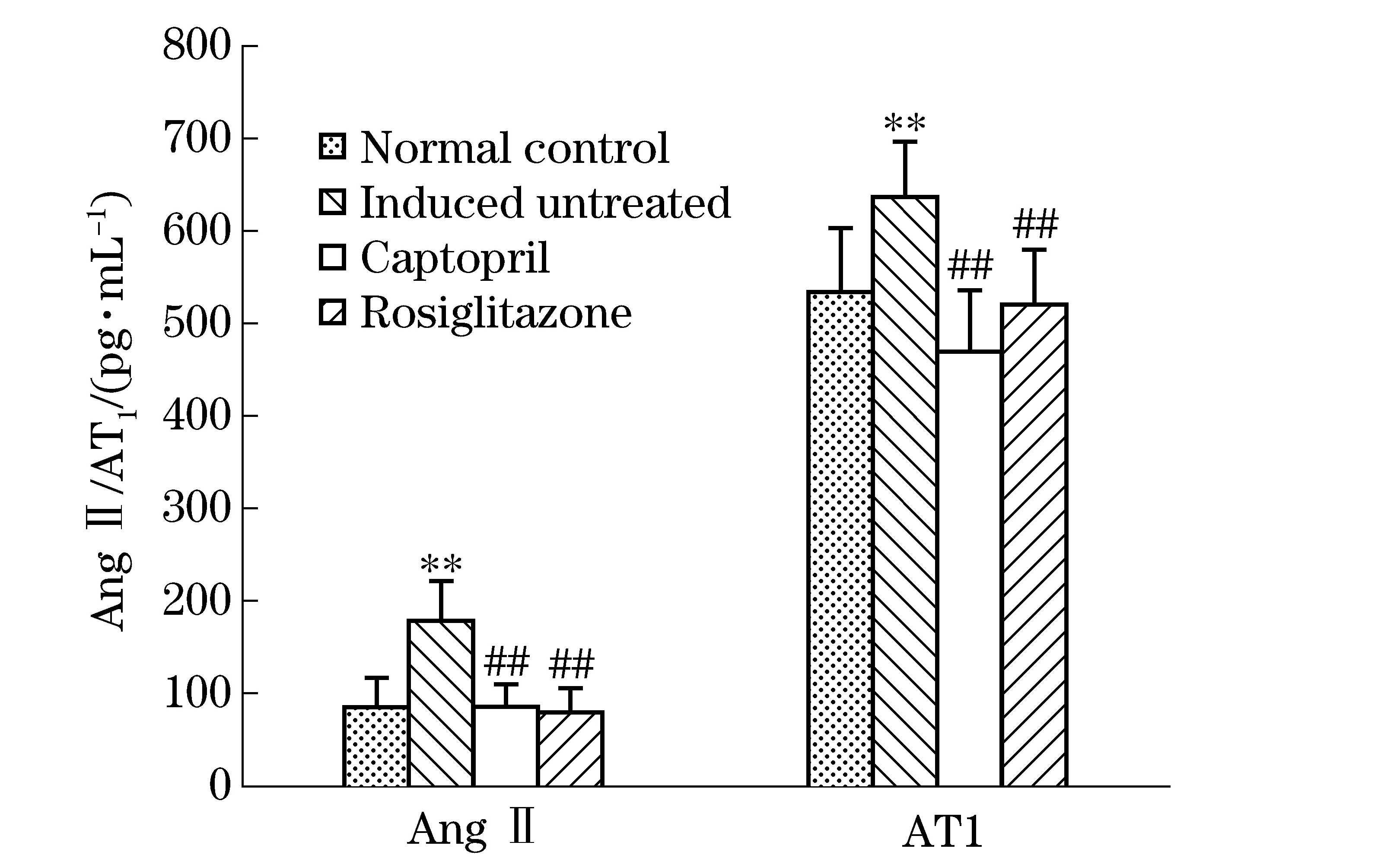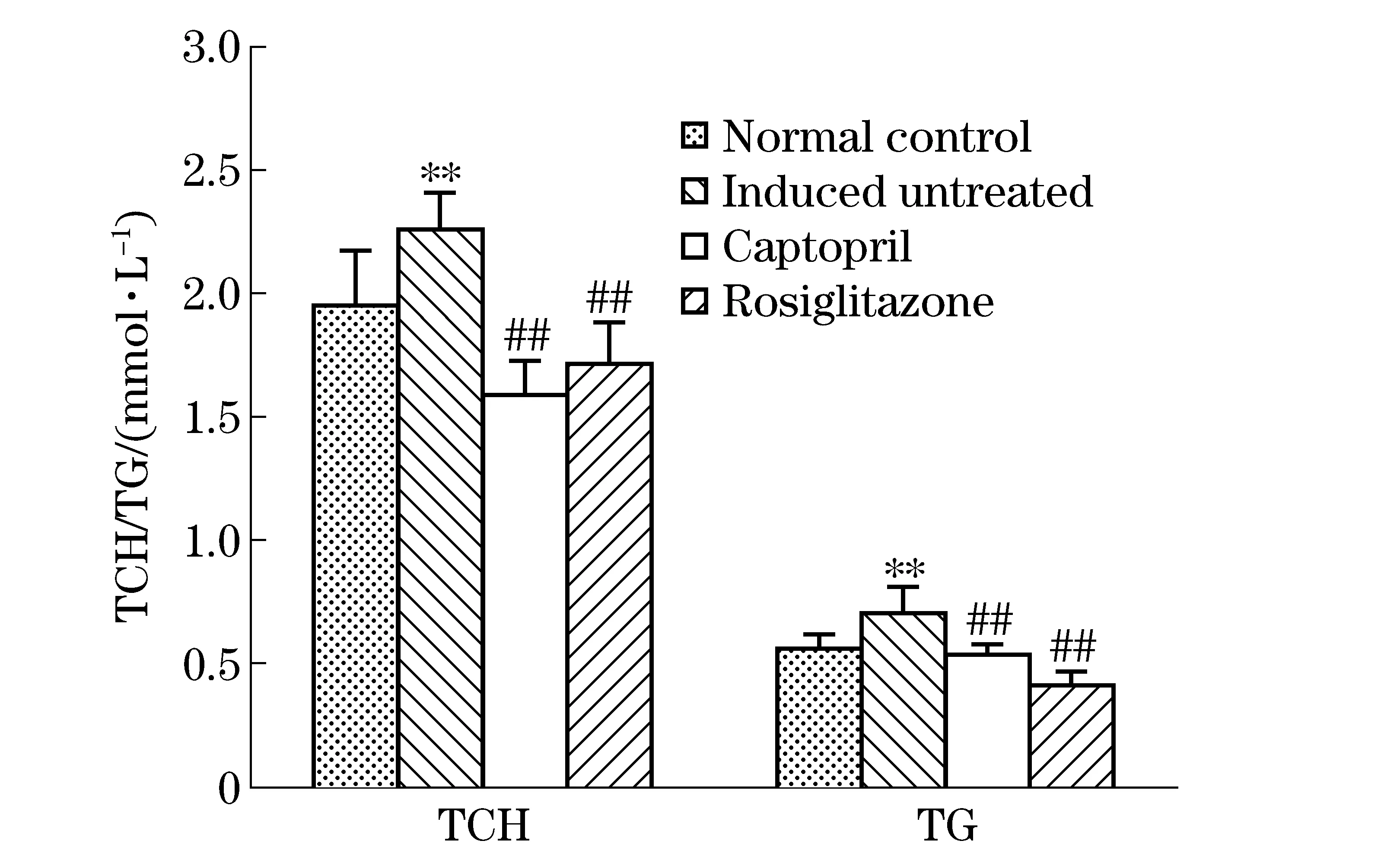Anti-hypertensive effects of rosiglitazone on renovascular hypertensive rats: role of oxidative stress and lipid metabolism
2015-04-22LIYan李岩GUONan郭楠FUZhenping付振平DONGJirui董继锐ZHAOJianpu赵剑璞FENGHuihong冯会红LIUPinduo刘品多XIAYu夏雨
LI Yan(李岩), GUO Nan(郭楠), FU Zhen-ping(付振平), DONG Ji-rui(董继锐),ZHAO Jian-pu(赵剑璞), FENG Hui-hong(冯会红), LIU Pin-duo(刘品多), XIA Yu(夏雨)
(School of Life Science, Beijing Institute of Technology, Beijing 100081, China)
Anti-hypertensive effects of rosiglitazone on renovascular hypertensive rats: role of oxidative stress and lipid metabolism
LI Yan(李岩), GUO Nan(郭楠), FU Zhen-ping(付振平), DONG Ji-rui(董继锐),ZHAO Jian-pu(赵剑璞), FENG Hui-hong(冯会红), LIU Pin-duo(刘品多), XIA Yu(夏雨)
(School of Life Science, Beijing Institute of Technology, Beijing 100081, China)
This study investigated the anti-hypertensive mechanism of rosiglitazone in renovascular hypertensive rats, and examined its relationship to oxidative stress and lipid metabolism. The renovascular hypertension was induced by stenosis of the left renal artery. Four groups of rats were selected: control, induced untreated, rosiglitazone (20 mg/kg) and captopril (10 mg/kg). After 14 d of administration, compared with induced untreated group, rosiglitazone group reduced the renovascular hypertensive rats’ systolic blood pressure and diastolic blood pressure, and decreased total cholesterol (TCH), triglyceride (TG), angiotensin II (Ang II) and angiotensin receptor (AT1) levels(P<0.05). Meanwhile, rosiglitazone remarkably decreased the levels of malondialdehyde (MDA) and hydrogen peroxide (H2O2) while improved the levels of supperoxide dismutase (SOD) and reduced glutathione (GSH). These results suggested that rosiglitazone could effectively decreased the blood pressure in renovascular hypertensive rats, and this might be performed by regulating the activity of angiotensin and the lipid metabolism and improving the oxidative stress.
rosiglitazone; renovascular hypertensive rat; lipid metabolism; oxidative stress
Human hypertension is a slowly-developed disorder, and involves the complex structural and functional alterations of its target organs. Hypertension is manifested by an increased arterial pressure[1]. Epidemiological data revealed that elevation of blood pressure alone in hypertension patients is less than 20%, most hypertension patients is always accompany with other metabolic disorder, such as obesity and lipid abnormality[2]. Chronic kidney artery diseases such as renal artery stenosis generally result in hypertension. Two-kidney, one-clip (2K1C) model in which one of the renal arteries is subjected to artery stenosis by clip placement, is one of the kidney related animal models of hypertension. Kidney ischemia leads to increase in plasma renin and angiotensin activity which successively results in persistent rise in blood pressure[3].
Thiazolidinediones (TZDs), a class of synthetic insulin-sensitizing agent (e.g., pioglitazone, rosiglitazone) used in the treatment of diabetes mellitus type 2, act by enhancing sensitivity to insulin to lower blood sugar. Overseas study found that in diabetic animals and patients, TZDs can not only lower blood glucose by enhancing insulin sensitivity, but also reduce blood pressure, suggesting that lower blood pressure is associated with enhanced insulin sensitivity[4-5]. As TZDs represented drug, rosiglitazone can improve insulin resistance and have a hypoglycemic effect which may be related to competitive peroxisome proliferator-activated receptor γandregulationofinsulingenetranscriptionreactivity[6-7].Althoughrosiglitazonereducesbloodpressurebyreducingtheroleofinsulinresistancehasbeenconfirmedbyclinicalandanimalstudies[8],itsmechanismremainsunclear.Toinvestigateanti-hypertensivemechanismofrosiglitazone,therenovascularhypertensiveratmodelwasinducedbystenosisoftheleftrenalartery,andangiotensinanditsreceptorlevel,lipidmetabolism,andoxidativestressweredetected.
1 Materials and methods
1.1Experimentaldrugs
RosiglitazonewasfromHenryPharmaceuticalCo.,Ltd.Chengdu(batchnumber: 110901).CaptoprilwasorderedfromNorthChinaPharmaceuticalCo.,Ltd. (batchnumber: 1109002).
1.2Preparationofhypertensionmodel
FortymaleSDrats(180-220g)werepurchasedfromthePekingUniversityHealthScienceLaboratoryAnimalScienceMinistry,CertificateofConformitySCXK-(Beijing) 2011-0012.Animalsweremaintainedunder12hlight/darkcyclesatatemperatureofapproximately24±1 ℃withfoodandwateradlibitum.After3days,animalswererandomlydividedintotwogroups,thecontrolgroupandthehypertensionmodelgroup.Leftrenalarterystenosiswasinducedusingthe2K1Cmethodtoestablishhypertensionmodel.Heartrateandbloodpressureinratsafteroperationweredeterminedbythedetector(CODAMonitorTypenoninvasivebloodpressuremeter,USAKentScientificCorporation).Bloodpressurewasmonitoredwiththetailcuffmethodfor4weeks.Ratswithhigherthan160mmHgsystolicbloodpressureswereselectedandrandomlydividedintothreegroups(n=8foreachgroup).Groupinganddosingregimenisasfollows:rosiglitazonegroup: 20mg/kg;captoprilgroup: 10mg/kg;blankgroupandmodelgroupweregivenanequalvolumeofsaline.Ratswereadministratedbyintragastricadministrationonceadayforconsecutive14days.
1.3 Blood pressure monitoring and sample collection
Rats’ blood pressures were measured at 0 d, 4 d, 7 d, 10 d, and 14 d respectively after administration. After the last administration, rats were anesthetized with 10% chloral hydrates (300 mg/kg, ip). Abdominal aortic blood samples were used to determine AngII (Beijing Biotechnology Co., Keno spring, lot: 20120501A), serum total cholesterol (kit, TCH, batch number: 2011110012), triglycerides (kit,TG, batch number: 2011110011), superoxide dismutase (kit,SOD, batch number: 20120306), malondialdehyde (kit, MDA, batch number: 20111101), reduced glutathione (kit, GSH, batch number: 20120515) and hydrogen peroxide (kit, H2O2, batch number: 20120511, purchased from Nanjing Jiancheng Bioengineering Institute). Rats were sacrificed to take kidneys for detecting angiotensin II receptor 1 (Angiotensin II type 1 receptor, AT1) (kit, Beijing Keno spring Biotech Co., Ltd., batch number: 20120501A).
1.4 Statistical analysis

2 Results and discussion
2.1 Effect of rosiglitazone on renal vascular hypertension in rats
Experimental results show that systolic blood pressure and diastolic blood pressureof model group were significantly higher compared with control group, rosiglitazone group and captopril group (P<0.01) on 0 d, suggesting the hypertension model was established successfully; after 14 d administration compared with model group, systolic blood pressure in captopril group and rosiglitazone group were significantly lower, with the average reduction of 20.2% and 30.0%, respectively (P<0.01). And the diastolic blood pressure were also significantly lower with the average reduction of 21.8%, 28.0% respectively (P<0.01). The results shown in Tab.1 and Tab.2 suggest that rosiglitazone has a significant anti-hypertensive effect on renal hypertensive rats.

Tab.1 Effect of rosiglitazone on systolic blood pressure in renovascular hypertensive rats ±s, n=8, mmHg)
Compared with control,*P<0.05, **P<0.01; compared with Induced untreated group,#P<0.05,##P<0.01

Tab.2 Effect of rosiglitazone on diastolic blood pressure in renovascular hypertensive rats ±s, n=8, mmHg)
Compared with control,*P<0.05, **P<0.01; compared with Induced untreated group,#P<0.05,##P<0.01
2.2 Effects of rosiglitazone on AngII and AT1in renal hypertensive rats
Experimental results(Fig.1) showed that: compared with the control group, the contents of Ang II, AT1in model group were significantly increased (P<0.01); compared with induced untreated group, the contents of Ang II, AT1in rosiglitazone group and captopril group were significantly reduced (P<0.01). Thus, the results suggested that rosiglitazone plays an important role of regulating the activity of the renin-angiotensin in vivo.
2.3 Effect of rosiglitazone on the levels of oxidative stress in renal hypertensive rats
Tab.3 showed that, the activity of SOD and GSH in induced untreated group was significantly lower than the control group (P<0.05), and MDA and H2O2content was significantly higher than the control group (P<0.05); SOD and GSH levels in rosiglitazone and captopril group were significantly increased compared with the induced untreated group. The level of MDA and H2O2were significantly reduced (P<0.05). Conclusion can be made that rosiglitazone can regulate SOD, GSH, MDA; H2O2levels, and enhance body’s ability of anti-oxidative stress to mediate the hypertension.

Fig.1 Effects of rosiglitazone on AngII and AT1 in renal hypertensive rats (compared with control, *P<0.05, **P<0.01; compared with Induced untreated group,#P<0.05,##P<0.01)
2.4 Effect of rosiglitazone on TCH and TG in renal hypertensive rats
As shown in Fig.2, TCH and TG serum contents in induced untreated group was significantly increased compared with the control group (P<0.05); Compared with induced untreated group, TCH, TG contents of the rosiglitazone group and captopril group decreased significantly (P<0.01). These results indicated that rosiglitazone had effect on the TCH and TG contents in renal hypertensive rats.

Tab.3 Effect of rosiglitazone on serum oxidative stress level in renovascular hypertensive rats ±s, n=8)
compared with control, *P<0.05, **P<0.01; compared with Induced untreated group,#P<0.05,##P<0.01

Fig.2 Effect of rosiglitazone on TCH and TG in renal hypertensive rats ±s, n=8)(compared with control, *P<0.05, **P<0.01; compared with Induced untreated group,#P<0.05,##P<0.01)
3 Discussion and conclusions
In the 2K1C model, renovascular hypertension is featured by elevated AngII expression resulted from ischemia in the clipped kidney and shear stress in the non-clipped kidney, activating rennin-angiotensial-aldosterone system (RAAS), and sustained increase of blood pressure. AngII is the primary effector molecule of the renin-angiotensin system. It is primarily recognized for its role in the regulation of arterial pressure and blood volume[9]. The effects of Ang II on cardiovascular and reproductive functions are mainly mediated through Ang II type 1 (AT1) receptor. Therefore, specific AT1antagonists are potentially useful for treating hypertension and for improving sexual dysfunction in hypertensive patients[10]. Our data suggest that rosiglitazone could decline the AngII content, and decrease the ability of the vasoconstriction. Meanwhile, the expression value of AT1in vivo was also reduced. Thus, rosiglitazone can inhabit RAS in rats, and improved hypertension system.
In previous studies, Raji et al. have showed a positive correlation between BP values and insulin sensitivity in patients treated with rosiglitazone[11]. Whether oxidative stress and lipid metabolism play roles in mediating the blood pressure in hypertension rat has not been determined. Lipid metabolism disorder can influence the membrane Ca2+transporters involved in the pathogenesis of hypertension through affect lipid structure[12]. Previous studies have found that cholesterol-lowering is beneficial to the reduction of blood pressure. The present study reveals that rosiglitazone can attenuate hypertension by the reduction of TCH and TG in renal vascular hypertension rats.
Oxidative stress has been implicated in pathophysiological conditions (e.g., cigarette smoking, hypercholesterolemia, diabetes, and hypertension[13-15]) that affect the cardiovascular system[16-18]. Oxidative stress is a major factor in mediating hypertension[10]. In spontaneously hypertensive rats, there is a found of increased level of oxyradical production from xanthine oxidase activity and the formation of lipid peroxide[19]. Level of MDA is an estimate of lipid per oxidation[20]. The results indicate that rosiglitazone could improve the levels of SOD and GSH, decrease the contents of MDA and H2O2, and improve the oxidative stress which maybe the mechanism of contributing to the reduction of blood pressure.
In conclusion, the present study reveals the potential protective effect of rosiglitazone against the renovascular hypertensive, which seems to be related to down-regulated activity of angiotensin, improved oxidative stress, and attenuation of serum lipid.
[1] Yu Tingting, Guo Kun, Chen Hanchun, et al. Effect of traditional Chinese medicine Xin-Ji-Er-Kang formula on 2K1C hypertension rats: role of oxidative stress and endothelial dysfunction[J].BMC Complementary and Alternative Medicine,2013,13:173-183.
[2] Pistrosch F, Passauer J, Herbrig K, et al. Effect of thiazolidinedione treatment on proteinuria and renal hemodynamic in type 2 diabetic patients with overt nephropathy [J]. Hormone and Metabolic Research, 2012, 44(12):914-918.
[3] Basile D P, Donohoe D L, Phillips S A, et al. Enhanced skeletal musclearteriolar reactivity to ANGII after recovery from ischemic acute renalailure [J]. Am J Physiol Regul Integr Comp Physiol2005,289:1770-1776.
[4] Yoshimoto T, Naruse M, Shizume H, et al. Vasculo-protective of insulin sensitizing agent pioglitazone in neointinmal thickening and hypertensive vascular hepertrophy [J]. Atherosclerosis, 1999, 145:333-340.
[5] Walker A B, Chattington P D, Buckingham R E, et al. The thiazolidinedione rosiglitazone (BRL-49653) lowers blood preasure and protects against impairment of endothelial function in Zucker fatty rats [J]. Diabetes, 1999, 48:1448-1450.
[6] Chen Junqun, Huang Qiren. PPARγand insulin resistance[J]. National Medical Frontiers of China, 2011,20:12-13
[7] El-Gowelli H M, Abd-Elrahman K S, Saad E I, et al. PPAR gamma dependence of cyclosporine-isoprenaline renovascular interaction: roles of nitric oxide synthase and heme oxygenase [J]. Journal of Cardiovascular Pharmacology, 2011, 58(2):173-180.
[8] Reaven G M. Banting Lecture 1998. Role of insulin resistance in human disease [J]. Diabetes, 1988, 37(12):1595-1607.
[9] Kim S, Iwao H. Molecular and cellular mechanisms of angiotensinII-mediated cardiovascular and renal diseases [J]. Pharmacol Reviews, 2000, 52:11-34.
[10] Karin Viana Weissheimer, Celso Rodrigues Franci, Aldo Bolten Lucion, et al. The role of AT1 receptor-mediated reproductive function in renovascular hypertension in male rats [J]. Hormones and Behavior 2012,62: 43-49.
[11] Annaaswamy Raji, Ellen W Seely, Shannon A Bekins, et al. Rosiglitazone improves insulin sensitivity and lowers blood pressure in hypertensive patients [J]. Diabetes Care, 2003, 26: 172-178.
[12] Xu Dingli. Hypertension and lipid metabolism disorder [J].Chin J Cardiol, 2006, 34:36-39.
[13] Steinberg D, Witztum J L. Is the oxidative modification hypothesis relevant to human atherosclerosis? [J].Circulation, 2002, 105:2107-2111.
[14] Chilsom G M, Steimberg D. The oxidative modification hypothesis of atherogenesis: an overview [J]. Free Radic Biol Med, 2000, 28:1815-1826.
[15] Cai H, Harrison D G. Endothelial dysfunction in cardiovascular disease: the role of oxidant stress [J]. Circ Res, 2000, 87:840-844.
[16] Denner L A, Rodriguez-Rivera J, Haidacher S J, et al. Cognitive enhancement with rosiglitazone links the hippocampal PPARgamma and ERK MAPK signaling pathways [J]. The Journal of Neuroscien, 2012, 32(47):16725-16735.
[17] Dong J, Wong S L, Lau C W, et al. Calcitriol protects renovascular function in hypertension by down-regulating angiotensin II type 1 receptors and reducing oxidative stress [J]. European Heart Journal, 2012, 33(23):2980-2990.
[18] da Costa C A, de Oliveira P R B, de Bem G F, et al. Euterpe oleracea Mart.-derived polyphenols prevent endothelial dysfunction and vascular structural changes in renovascular hypertensive rats: role of oxidative stress[J]. Naunyn-Schmiedeberg’s Arch Pharmacol, 2012, 385:1199-1209.
[19] Suzuki H, Delano F A, Parks D A, et al. Xanthine oxidase activity associated with arterial blood pressure in spontaneously hypertensive rats [J]. Proc Natl Acad Sci USA, 1998, 95:4754-4759.
[20] Varga E,Bodi A,Ferdinandy P. The protective effect of EGb in isolated ischemic/reperfused rat hearts: a link between cardiac function and nitric oxide production [J]. Cardiovasc Pharmacol, 2001, 34(5):711.
(Edited by Wang Yuxia)
10.15918/j.jbit1004-0579.201524.0321
R 977 Document code: A Article ID: 1004- 0579(2015)03- 0422- 05
Received 2014- 01- 07
E-mail: leeyan@bit.edu.cn
猜你喜欢
杂志排行
Journal of Beijing Institute of Technology的其它文章
- High-rise building fire pre-warning model based on the support vector regression
- Dynamic modeling and simulation for the flexible spacecraft with dynamic stiffening
- Experimental study on the time-dependent dynamic mechanical behaviour of C60 concrete under high-temperatures
- Experimental study on compression stroke characteristics of free-piston engine generator
- Numerical simulation and optimization of the cylinder head water jacket based on the two-phase flow boiling heat transfer
- Multi-action-based approach for constructing knowledge map
